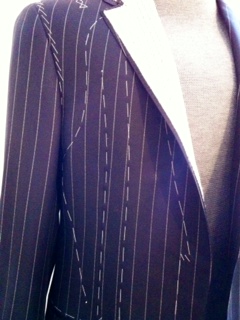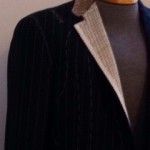Jacket Construction 101
All about: fusing, canvas, half-canvas > cost, comfort and value.
We pride ourselves on stocking some of the finest quality-to-price ratio suits and sports jackets from brands such as Samuelsohn and Jack Victor. One of the critical components we consider when selecting product for Drinkwater’s is the garment’s construction. As with many other products, a majority of the cost and its life expectancy (value) is based on construction.
You’ve probably heard discussions of half-canvassed versus fully canvassed suits and sports jackets and how they are inherently superior to “fully fused” products.
What exactly is canvas and how is it so influential in shaping a quality garment? To not overcomplicate things, canvas, as we refer to it, is the foundational layer of a suit or sports jacket, usually made from of a blend of wool, cotton, and animal hair (e.g. horse, camel). These components are used in various combinations to produce differing grades of canvas to complement the varying fabric weight ranges.
Canvas made of these materials is molded using humidity, heat, and pressure to achieve—and more importantly retain—a garment’s shape. A fully canvassed jacket has canvas from the top of the shoulder to the bottom of the coat’s hem in the front. This, of course, includes the all-important lapel, in which the canvas is pad-stitched and rolled, giving it an elegant bloom that cannot be achieved in a fused jacket.
In ‘fusibles’, the jacket’s interlining has a resin applied to it, which when heated melts and glues the cloth to lining with a tight, rigid bonded seal. You have probably seen the horrific “bubbling” on some older fused jackets—this bubbling is the delamination of the bond—an obvious sign of poor construction and a cheaply made product.
That being said, fusing technology has come a long way in the past few decades, and current fused garments are less subject to delamination if properly handled (particularly when dry cleaning) to preserve the bond as it was set in the factory. It is worth noting, however, that the fusing process stiffens the cloth, and because no canvas is utilized in this construction within the lapel, the lapel presents itself as relatively flat and lifeless in comparison to a fully or even half canvassed jacket.
Fusibles cannot compete with the drape, support, and overall expression a fully canvassed jacket has throughout its entire front. Better yet, a sewn, floating canvas is at absolutely no risk of delamination, extending its longevity. Naturally, the materials and extra labor that goes into making this premium garment drives up the price proportionately, making a fused jacket’s entry-level cost a practical, short-term solution.
This is where half-canvassed jackets come into play, taking advantage of both fusing and canvassing methods. A half-canvassed jacket has a canvas that covers the top half of the jacket, specifically the chest and lapels, where canvassing is needed most to inject some character and shape. A good lapel roll and chest drape can still be obtained in a cost saving manner, as the remainder of the coat front from the lapel downwards is stabilized by means of fusing.
For a much more in-depth article go to: http://www.blacklapel.com/thecompass/anatomy-of-a-suit-jacket-fused-vs-canvassed/
Armed with this knowledge of suit and sport jacket construction, we invite you to stop by the store, we’d love to show you our half and fully canvassed offerings for Spring/Summer 14.



